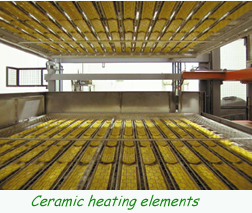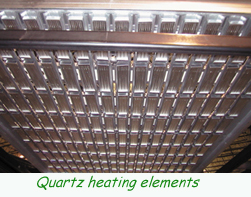|
THERMOFORMING: Cut Sheet Thermoforming "Ovens"
One of the most
important factors
in the thermoforming
process is to
have the proper heat.
In order to accomplish
this, you must have an
oven designed to be
most efficient and most
effective for your applications.
Although there
is no single heating element
that is considered
the best for every application,
more and more research and actual trials are
being done that help prove certain applications can be
better accommodated with application-specific-ovens, elements
and their associated technology.
Second to having good sheet material, the next critical
factor in the thermoforming process is heating the sheet
correctly. The sheet must be heated uniformly to its processing
temperature in order to avoid over heating or under
heating the sheet. This is best accomplished by using an
engineered, highly zoned oven with the latest oven controls.
Heating Elements
In cut sheet thermoforming the use of electric heating is
still by far the most popular method and also where the
most industry technology
exists. The electric
heaters used today have
much higher temperature
capabilities than
current gas heating elements,
which link to creating
faster cycle times.
Electric heaters can be
as simple as bare
nichrome wires or metal
tubular heaters (calrods).
More popular
today are the ceramic,
quartz and halogen heaters. All of these heating elements
have some advantages and disadvantages but the key is to
understand these and equip your machine with the best
suitable element.
- Bare nichrome wire heaters:
Although rarely used in
any of today’s thermoforming machines these elements
still exist mainly due to budget restraints. The very inexpensive
costs of the initial purchase of these elements
cannot be beat. In addition, they are simple to repair
and replace. However, these elements are no longer
being utilized because they limit your zoning capabilities,
tend to heat non-uniformly and are very inefficient
for the process. In the long run, the price you will pay
for all the inefficiencies these cause are sure to exceed
any other heating element costs.
- Metal tubular heaters (calrod):
The metal tubular
heater has also had its day. Prior to the 1990’s the calrod
could have been claimed the most commonly used
element. They last a very long time, and are somewhat
inexpensive to build into an oven. However, the metal
tubular heaters tend to age and degrade quickly therefore
creating many inefficiencies. They also require
longer heat-up times, heat non-uniformly and limit the
possibilities to highly zone an oven. The associated
costs of building a good highly zoned calrod oven is
almost as costly as manufacturing a ceramic oven,
which just makes it harder to justify in today’s market.-
Ceramic:
The ceramic element may still be the most
widely used in today’s thermoforming machines.
 The
rotary style machine is the largest consumer of this element. It is very versatile, long lasting, easily zoned,
and very efficient in production. The ceramic element is
typically favored when it is considered for longer production
runs because it is durable and maintains excellent
uniform heat. The only drawback to the ceramic element
is typically related to the moderate heat up times
and slower response times when being compared to
quartz or halogen. Since ceramic elements have become
so popular, pricing has become much more attractive.
The
rotary style machine is the largest consumer of this element. It is very versatile, long lasting, easily zoned,
and very efficient in production. The ceramic element is
typically favored when it is considered for longer production
runs because it is durable and maintains excellent
uniform heat. The only drawback to the ceramic element
is typically related to the moderate heat up times
and slower response times when being compared to
quartz or halogen. Since ceramic elements have become
so popular, pricing has become much more attractive. -
Quartz and Halogen: The quartz and halogen elements
are continually gaining a larger share of new
machinery being sold today.
 They tend to be best used
in shuttle type machinery rather than rotaries due to
their faster response times. These elements are also
very versatile, have excellent temperature control and
are easily zoned like the ceramic. An additional advantage
with both quartz and halogen elements is the ability
to incorporate heat levels or heat steps within a
cycle. With the quick response times, different controllable
heat levels are allowing thermoformers to
decrease cycle times when applied. As the quartz element
is becoming an industry standard in shuttle type
machines, halogen seems to be most often used for
more specific material applications rather than an “allaround”
element. The only drawback to thermoformers
today tends to be based on longevity. These elements
are constructed of quartz glass tubes which make them
much more fragile and easier to damage. Their life
expectancy is slightly lower than the ceramic and they
are typically more expensive.
They tend to be best used
in shuttle type machinery rather than rotaries due to
their faster response times. These elements are also
very versatile, have excellent temperature control and
are easily zoned like the ceramic. An additional advantage
with both quartz and halogen elements is the ability
to incorporate heat levels or heat steps within a
cycle. With the quick response times, different controllable
heat levels are allowing thermoformers to
decrease cycle times when applied. As the quartz element
is becoming an industry standard in shuttle type
machines, halogen seems to be most often used for
more specific material applications rather than an “allaround”
element. The only drawback to thermoformers
today tends to be based on longevity. These elements
are constructed of quartz glass tubes which make them
much more fragile and easier to damage. Their life
expectancy is slightly lower than the ceramic and they
are typically more expensive.
Element Rating And Oven Design
In addition to understanding the element types available
and their characteristics, it is just as important to
consider the elements watt rating and how it is designed
into the oven’s construction. The distance from the element
to your material, the spacing between elements and,
maybe even more important, what you control the elements
with. There are formulas, calculations and application-
specific fundamentals to bear in mind in order to
design an oven. An oven designed with too little wattage
can create very long cycle times, whereas an oven with too
much wattage can degrade the sheet and/or drive day-today
electricity costs up. Different types of oven enclosures
can also affect the performance of your oven. A good oven
design should restrict external drafts and isolate the sheet
from the environment outside the oven station.
Although today’s ovens and heating elements are much
more efficient and hold similar characteristics, they are
becoming much more complex. Now thermoformers are
taking this to the next level and the continued research is
developing more answers. Which element is best to heat a
High Density Polyethylene (HDPE) or Polycarbonate? What
is better for thick gauge, highly engineered and/or multilayered
materials? What about different color materials?
These questions are being asked more often due to the
increase in competition and the determination to be most
efficient. Answers to these questions are being tested and
in some cases proven in the field today. Prior to considering
a new thermoforming machine or rebuilding an oven
that will keep you up to current technology, it is best to
consult an industry professional and learn what can put
you ahead of the pack.
Written by Michael P. Alongi, Sales Director for MAAC
Machinery Corp., manufacturers of a wide range of cutsheet
thermoforming machinery.
For more information, contact MAAC Machinery Corp., 590 Tower Blvd.,
Carol Stream, IL 60188, 630-665-1700, Fax: 630-665-
7799, E-mail: sales@maacmachinery.com, Web: www.
maacmachinery.com.
|